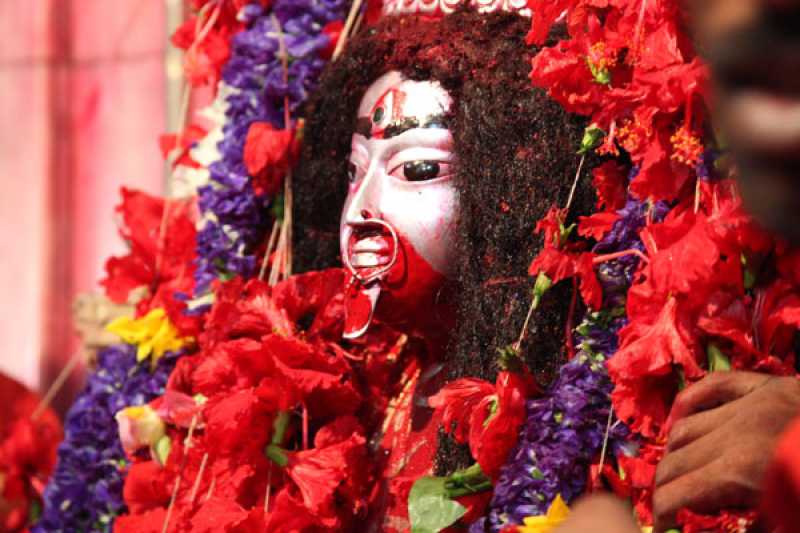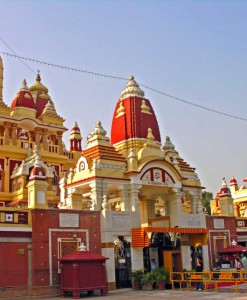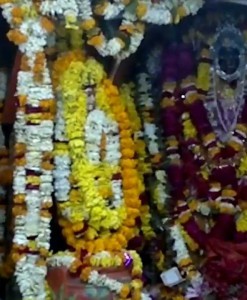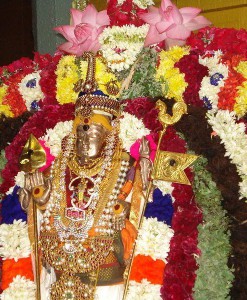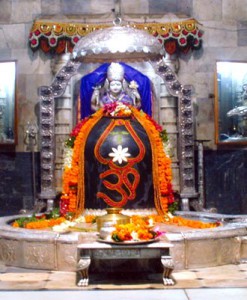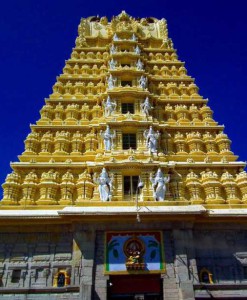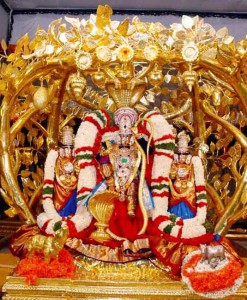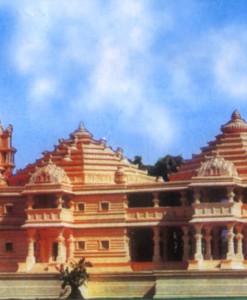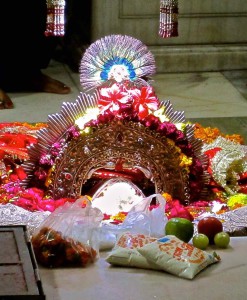No products in the cart.
Tarapith Temple, West Bengal
Tarapith Temple is situated on the banks of the north flowing Dwarka River, Birbhum, some 264 km from Kolkata, West Bengal. Tarapith Temple is regarded as one of the Mahapeeths and extremely holy place for all Hindus. It is believed that the eyeball of Sati fell down at Tarapith. In Bengali, the eye ball is called ‘Tara’ and that is why the name of the village was changed from the earlier Chandipur to Tarapith.
Tarapith Temple is quite renowned for being one of the few temples where tantric rituals of Hinduism are followed. Dedicated to Goddess Tara, a fearsome incarnation of the Divine Mother, this is the most important center for Tantrik worship in India
The temple is symbolic of Shiva’s destructive aspect in the form of Kali. Her bloodlust is said to be assuaged by an animal sacrifice each morning in the temple premises and the blood is offered to satisfy her. In Hinduism, Maa Tara is the second of the Dasa (ten) Mahavidyas or “Great Wisdom [goddesses]”.Here tara means “star” because eye ball of Devi Sati fall here. She is also known as Kalika, Ugra-kali, Mahakali and Bhadra-kali. She is the tantric manifestation of Durga or Mahadevi, Kali, or Parvati.
The main temple is a four-sided, marble block structure capped by a curved roof called a dochala, from which projects a smaller four-sided tower with its own dochala.
Tarapith Temple base is thick with thick walls, built of red brick. The superstructure has covered passages with many arches raising to the pinnacle with a spire (shikara). The image of the deity is enshrined under the eaves in the sanctum. There are two Maa Tara images in the sanctum. The stone image of Maa Tara depicted as a mother suckling Shiva – the “primordial image” (seen in the inset of the fierce form of the image of Tara) is camouflaged by a three feet metal image, that the devotee normally seen. It represents Maa Tara in her fiery form with four arms, wearing a garland of skulls and a protruding tongue. Crowned with a silver crown and with flowing hair, the outer image wrapped in a sari and decked in marigold garlands with a silver umbrella over its head. The forehead of the metal image is adorned with red kumkum (vermilion). Priests take a speck of this kumkum and apply it on the foreheads of the devotees as a mark of Maa Tara’s blessings. The devotees offer coconuts, bananas and silk saris, and unusually bottles of whisky. The primordial image of Maa Tara has been described as a “dramatic Hindu image of Maa Tara’s gentler aspect”.
Story behind the Tarapith Temple begins with Vashishta’s desire to master the Tantrik Arts. When he doesn’t get success after long practices he visits Buddha who had a vision of Tarapith being the perfect location to worship Maa Tara. On Buddha’s instructions Vashishtha came to Tarapith and worshipped the goddess by the left-handed Tantrik ritual utilizing the 5 forbidden things (Panchamakara). Maa Tara pleased with his devotion appeared before him in the form of the Divine Mother suckling Shiva to her breast and then turned to stone. Since then, the image of Maa Tara in her motherly incarnation suckling Lord Shiva is worshipped at Tarapith.
The old temple of Goddess Tara is somewhat damaged. The present temple with eight roofs was built in 1225 by one Jagannath Ray of Mallarpur village. On the main gate of the temple the statue of Goddess Durga and her full family are carved. On the left, the war of Kurukshetra (Mahabharata) and on the right stories from Ramayana is depicted.
Tarapith is also famous for Bamakhepa known as the ‘mad saint’, who is worshipped in the temple. He resided in the cremation grounds as a mendicant and practiced and perfected Yoga and the Tantric art under the guardianship of another famous saint known as the Kailashpathi Baba. Bama Khepa dedicated his entire life to the worship of mother Tara. His ashram is also located close to the temple.
Unlike most Indian villages and towns, the smashan or cremation ground is not situated on the periphery of the village. As cremation grounds are seen to be polluting, most Indian smashans are located far from the center of town. Both the Tarapith mandir and smashan are very close (within 100 yards or so) to the center of the town. It is said that Tara Maa’s footprints are preserved in the smashan; this is a common theme in Hinduism, where deities or their especially holy followers are said to leave their footprints in rocks. Many Sadhus and Tantrikas live in the smashan, some with permanent huts as residences. The smashan is filled with dogs, traditionally polluting animals that were said to share food with the Vamamarga saint Bamakhepa, whose samādhi or tomb is located next door to the main Tarapith temple.
The Tarapith Amavasya Annual Festival is the most important festival here which is celebrated in August every year.
Prarthana in Tarapith Temple
Early morning at 4’O clock Devi Tara wakes up from her sleep with the symphony of shahnai and other musical instruments and after that the process of her worship gets start. According to rules, a group of followers open the door to the garbha griha or sanctum sanctorum, wash her feet, clean the room and undo her bed. After this ghee, honey and aromatic oil are applied to the sacred stone idol before washing it with the water of the pure Jivitkund. After bathing the idol it is embellished with a saree, mask and a garland of skulls. Then starts the mangalarti and the morning bhog or morning food offering. Again in the afternoon puja is commenced and annabhog or rice offering is presented according to the norms of tantric sadhana. The annabhog consists of atap rice, five kinds of dishes, fried fish, meat of sacrificed goat, payesh or rice pudding and karanbari or alcoholic beverage. After the annabhog, the temple is closed for some time for the deity to take some rest. The sandhya aarti takes place in the evening followed by the making up of her bed for sleeping on a beautifully adorned bedstead.
Tarapith Temple is usually crowded by the poor from the nearby villages waiting for their daily free meal. The priests adorn vermillion on the forehead of the goddess. Speck of this vermillion is put on every devotee’s forehead as Ma Tara’s blessing. Devotees offer food, silk sarees and sometimes bottles of whiskey to the goddess. Puja is done to bring out the peaceful motherly nature of Ma tara for the benefit of her devotees. After a ritual sacrifice, sometimes devotees smear a little blood on their forehead as a mark of respect for the goddess.
Blood sacrifice of goats is the daily norm in the temple. Devotees who offer such goat sacrifices seek blessings from the deity. They bathe the goats in the holy tank near the temple before the sacrifice. They also purify themselves by taking bath in the holy tank before offering worship to the deity. The goat is then tethered to a stake, the designated post in a sand pit, and the neck of the goat butchered with a single stroke by a special sword. A small quantity of the blood of the goat is then collected in a vessel and offered to the deity in the temple. The devotees also smear their forehead with a bit of blood from the pit, as a mark of reverence to the deity.
Tarapith Temple Daily Pooja Schedule
Open all days of the week: 6:00 AM – 9:00 PM
As regards the birth of Shani, there are different stories. Foremost and accepted is the one in the ancient ‘Scanda Poorana’ of Kasi Khanda which is as follows.
God Surya was married to Daksha daughter Sadnya. Sadnya could not tolerate the radiance of God Surya. She used to feel that by doing penance she could increase her brilliance. Or, by the power of her penance, she could diminish the glare of God Surya. But for God Surya, she was a spouse worshipping wife. From God Surya, she had three children. One was Vaivastahva Manu. The second was Yama Raj. And the third was Yamuna. Sadnya loved her children very much. But, she was very upset with the radiance of God Surya. One day, she thought that she would separate from God Surya, go to her parents’ home and undertake great penance. And if there was opposition, she would go far away to a lonely and undertake great penance.
By strength of her penance, Sadnya created a ‘Chaya’ (shadow) of herself and named her Suvarna. And, and then the shadow of herself became Suvarna. After handing over the children to Chaya, Sadnya told her that Chaya would thereafter play the role of womanhood and nurse her three children. She told her if any problem arose, she should call her and she would come rushing to her. But she cautioned her that she must remember that she was Chaya, not Sadnya, and nobody should know this difference.
Sadnya hander over her responsibilities to Chaya and went away to her parents’ place.
She went home and told her father that she could not stand the radiance of God Surya. And therefore, without telling her husband she had come away. Listening to this, her father scolded her very much and told her that without being called, if the daughter returns home, both her and her father would be cursed. He told her to go back to her home immediately. Then, Saudnya began to worry that if she went back, what would happen to the responsibilities which she had given to Chaya. Where would Chaya go?
And their secret would be exposed. So, Sadnya went to the dense jungles in Uttar Kurukshetra and took repose there.
She was fearful of her safety in the jungle because of her youthfulness and beauty. And she changed her form into that of a mare so that none could recognize her and started her penance. Elsewhere, the union of God Surya and Chaya begot three children. God Surya and Chaya were happy with each other. Surya never doubted anything. The children of Chaya were Manu, God Shani and Putri Bhadra (Tapti).
As per the second story, the creation of God Shani was the result of Maharishi Kashyap’s great ‘yagna’. When God Shani was in the womb of Chaya, Shiv Bhaktini Chaya was so engrossed in penance of God Shiva that she did not care for her food even.
She prayed so intensely during her penance that the prayers had a profound influence on the child in her womb. As a result of such a great penance of Chaya, without food and shade in the blazing sun, the complexion of God Shani became black. When God Shani was born, Surya was surprised to see his dark complexion. He began to doubt Chaya. He insulted Chaya by saying that this was not his son.
From birth itself, God Shani had inherited the great powers of his mother’s penance.
He saw that his father was insulting his mother. He saw his father with a cruel gaze. As a result his father’s body was charred black. The horses of God Surya’s chariot stopped. The chariot would not move. Worried, God Surya called out to God Shiva. God Shiva advised God Surya and explained to him about what had happened. That is, because of him the respect of mother and child had been tarnished and insulted. God Surya accepted his fault and apologized. And regained his earlier glorious looks and the power of his chariot’s horses. Since then, God Shani became a good son to his father and mother and an ardent disciple of God Shiva.
In our routine lives, there is a great importance of the kindness and the power of God Shani. Shani occupies the seventh place among the nine planets which govern the world. This is viewed as unlucky in conventional astrology. As per ‘Kaagol Shastra’, the distance of Shani from the earth is 9 crore miles. Its radius is about one billion and 82 crore and 60 lakh kilometers. And its gravitational force is 95 times higher than that of the earth. Planet Shani takes 19 years to complete one revolution around the Sun. The astronauts have viewed the Shani’s colours as beautiful, strong, influencing and eye-catching. It has twenty two satellites in its ring.
Shani’s gravitational power is more than that of the Earth’s. Therefore, when we think good or bad thoughts and make plans, they reach Shani by the strength of his power. In astrological terms, the bad influence is considered as unlucky. But the result of good deeds will be good. Therefore, we must understand God Shani as a friend and not as foe. And for bad deeds, he is Sade Saathi, disaster and an enemy.
Tarapith is a temple town in Birbhum. It is a major Hindu pilgrimage centre and several thousand devotees visit the temple every day.
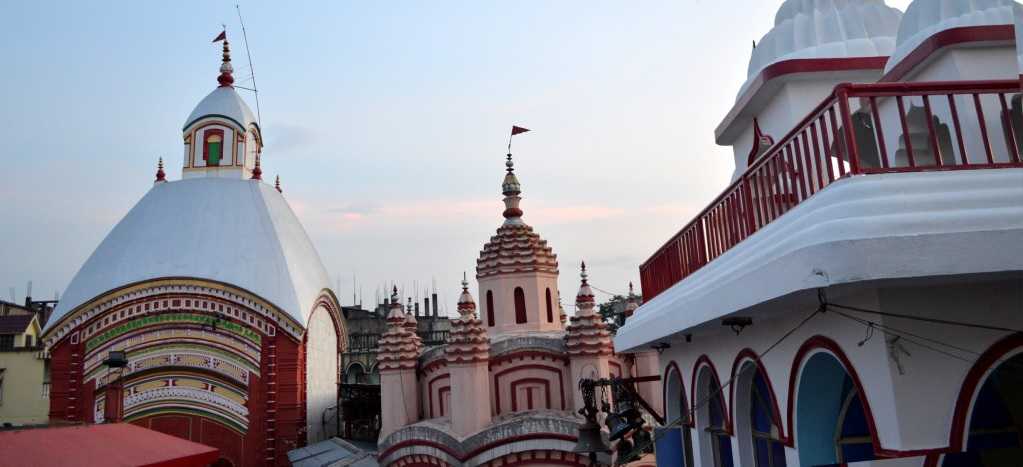
Tarapith is at a distance of 264 km from Kolkata, 96 km from Santiniketan, 116 km from Durgapur, 150 km from Deoghar and 205 km from Mayapur.
If you want to make a travel to this place you can choose any of the following options:
Tarapith Temple By Bus
The state owned buses connect Tarapith with to Esplanade/Dharamtalla bus stand of Kolkata or with the neighboring cities.
Tarapith Temple By Air
The nearest airport is at Kolkata, at a distance of 225 km from Tarapith. One can avail taxi services from airport to Tarapith. From Kolkata Delhi, Mumbai and other major airports are easily accessible.
Tarapith Temple By Train
The nearest railway station is Rampurhat, at a distance of about 9 km from Tarpith. Taxi services from railway station to Tatapith are available. Rampurhat is linked with Howrah and Sealdah.
Tarapith Temple, West Bengal

